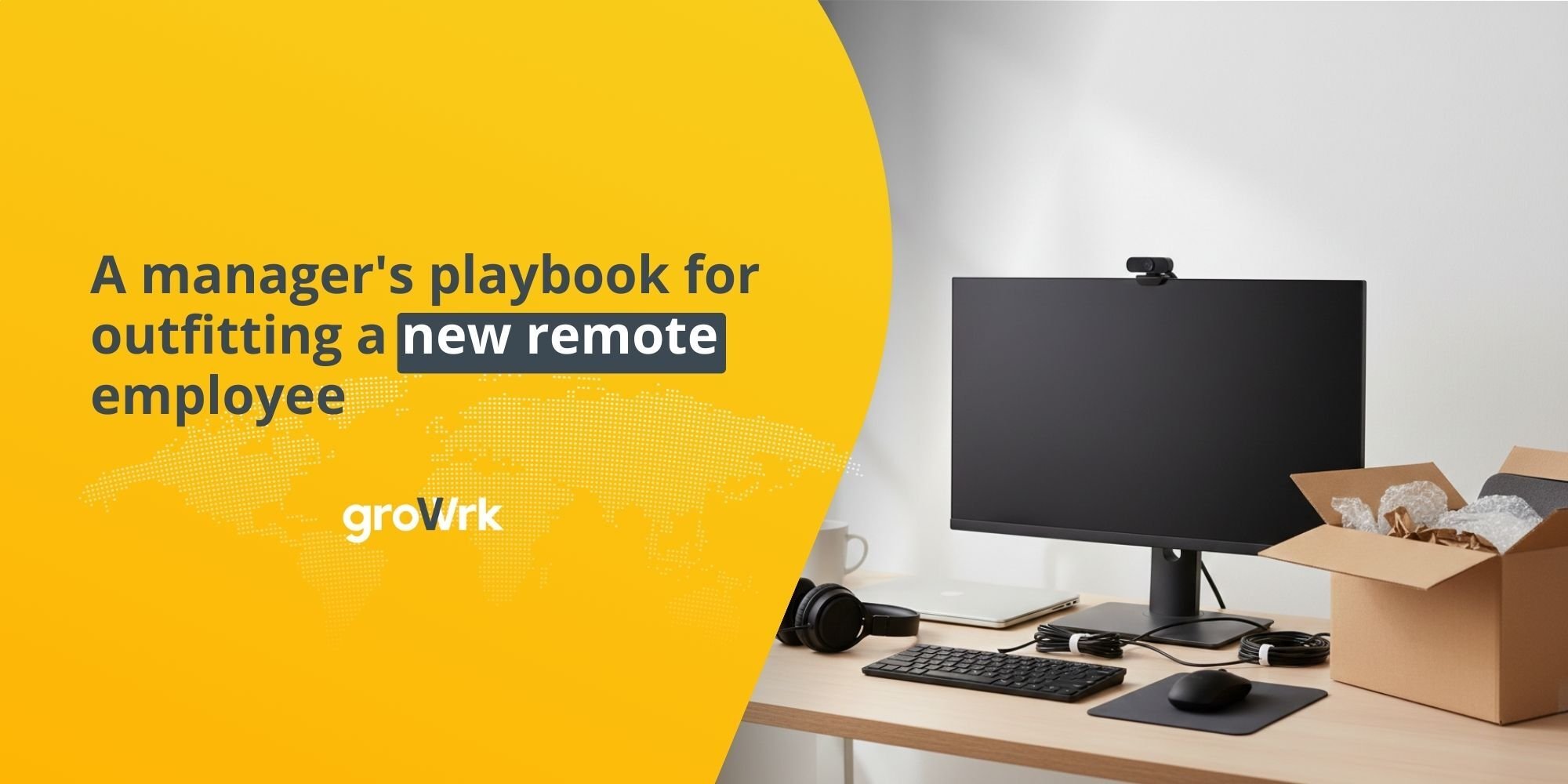Defining And Building A Remote-First Culture For Your Company
 GroWrk Team
GroWrk Team
If you’ve never met your co-workers in person, do you even work there? That was the question posed by a recent New York Times article. It touched upon a critical failure of many companies that have gone remote: Making their employees feel like they belong.
The one element they have been missing? Building a remote-first culture.
In our weekly newsletter, The Remote Times, we interview remote work leaders or specialists on their tactics for succeeding in the future of work.
A common trend that has shown up is that for remote work to be genuinely transformative, companies need to change their mindset on how they create their culture.
This article will cover their key insights and strategies to build a remote-first culture for your distributed or hybrid company.

What is a Remote-First Culture?
A remote-first culture is a company culture built on the concept that everyone is remote even if people are working together in person. The building blocks of company culture like communication, team building activities, company events, values, and ethics are all created with remote workers in mind.
Dropbox’s version of remote-first is where employees work remotely by default but would have access to collaborative spaces called “DropBox Studios.”
Gary Walker, a remote work specialist and product director at 22 North, says that you need to have a remote-first mindset to create a remote-first culture.
Remote-first vs. remote-friendly
So, while remote-first cultures work remotely by default, remote-friendly cultures just allow remote work to happen. This is a critical difference because it sets the standard for two different experiences for your co-located and remote employees.
When you have a remote-friendly culture, most company interactions are prioritized for in-person. Company events, communication, feedback, and team-building all happen from one central location.
This made sense for companies before the pandemic with large headquarters and small teams of remote workers because the focus was on creating relationships and identity around the office.
As companies shifted to remote during the pandemic and now are coming back to the office in hybrid setups, this type of culture is no longer sustainable for the vast majority.

It creates a disjointed employee experience for those who want to stay remote or not come into the office every day of the week. Most importantly, it opens up your culture for remote workers to miss promotions and ultimately leave because they don’t feel connected to the company.
There is a balance between asynchronous work, virtual company meetings, and yearly in-person company gatherings in Remote-first culture.
Remote-friendly teams invest in a dedicated in-person HR staff to foster culture. Remote-first teams emphasize digital company handbooks and hire a Head of Remote to encourage virtual interactions.
In remote-first cultures, operations are never slowed by everyone being remote. The company is much more adaptable to changing economic environments.
As Lisette Sutherland, Director of Collaboration Superpowers and remote worker with 17 years of experience, says:
Many people want to go back to the way things were before the pandemic. But all the data points to the fact that the future of work will be a choice.
- For the individual to work when and where they are most productive
- For companies to be able to hire more broadly and to be able to shrink and expand according to their needs.
One of the biggest mistakes people are making is not adapting to remote/hybrid as a new work medium. We can’t take what we did in the office and just translate it online. We have to adapt how we work to the online medium.

How to create a remote-first culture outline
Building a remote-first culture isn’t as easy as having virtual happy hours every other month.
It requires intentionality.
Just like office culture, you build it on pillars that range from how you communicate with each other to your values and the benefits you offer.
How much effort you put into building determines employee experience and your overall success.

So, what are some pillars that you can consider? The first place to start is by creating a company handbook or culture outline that everyone can look at as the one source of truth for the organization. You can then construct your pillars from there.
Here are some of the elements that remote experts recommend to include.
Communication
Establishing communication guidelines sets a standard for how your remote teams interact with each other. This framework helps prevent a culture of anxiety where people feel they need to be on call 24/7. It establishes a culture that sets healthy boundaries between work and personal life.
It sets clear expectations and lets everyone work at their most productive hours without being interrupted.
If you are a hybrid organization should be to have everyone take calls from their computer even if they are in the same room together. This sets a precedent for honest communication in meetings between people in the office and remote workers.

We spoke to the VP of Remote Communications at Vistaprint and Cimpress, Paul McKinlay, to see how he viewed the importance of an internal communications guide.
Communication is the basis of shared understanding and team cohesion.
A formal internal communications guide ensures that everyone — regardless of location — has access to the ins and outs of where workplace communication flows and where informal bonding occurs.
The first step to getting teams on the same page is ensuring they’re speaking in the same venue. In distributed teams, it’s critical to document where communication happens, so there’s no guesswork involved.
A formal location creates a single source of truth where everyone can check-in and read the latest without needing a status meeting.
We created an early iteration shortly after the pandemic led Cimpress to make a bold call: to make remote-first a towering part of our culture.
We appointed someone to erect, curate, and evolve a company handbook, of which an internal communication guide was a founding pillar.

Inclusion
A problem in many company cultures that existed even before the world went remote was making each employee feel included in the mission.
With the absence of in-person interaction, it is even easier for team members to slip through the cracks.
By making diversity and inclusion a pillar of your remote-first culture, you encourage all of your employees to be their true selves.
It opens up dialogues about topics other than work and creates stronger bonds across the team.

Rowena Hennigan, a Top 25 Remote Innovator in 2021 and Founder of RoRemote, gave her tips for building a more robust remote culture with a remote team.
Start by creating an ethos statement, HR guidebook and begin to record and describe the elements of your own 'team culture' that live in your organization or team.
Every organization wants to ensure that team members with issues or challenges feel they can speak up, be heard, and get support. This happens mainly through small gestures every day, as well as within written policies.
For example, team leaders checking in on their reports, offering a mentoring system within your organization, maybe providing external counselors or support resources for your employees.
Some organizations train some or all staff as mental Health First Aiders.
Many remote-first organizations have bolstered their initiatives with extra days off (#restethic by GitLab campaign), organized additional online events and support where possible, and encouraged small in-person meetings with local team-mates (providing food vouchers too!).

Employee engagement
Your pillar of engagement and support should be more than meetings, 1:1s, and the odd virtual party.
Informal communication is as important as daily standups in building connections across your organizations.
As many CEOs would like you to believe, the water cooler is not where culture is made. However, it still plays an essential role in creativity and innovation.
Virtual interactions can totally replicate this, and Rowena shares her tips on how to do it:
Variety is the spice of life, as the old saying goes! So I recommend looking at all the various touchpoints where workers can chat informally, share photos, images, gifs, and jokes. Most likely, this is on Slack and IM systems.
Visual Collaboration boards and galleries could hold holiday or sports challenges images. Also, galleries can hold images to introduce individuals’ families, personal interests, and their home or coworking setup.
You can use software like Donut on Slack to introduce members casually for coffee calls and chats every week. Also, external to the organization, Meet Cafecito could be used for these informal chats in the wider Remote Worker community.
Some teams have a regular quiz, book club, or sports events they organize on video conferencing systems.
Ultimately, we all want to interact in real life. As restrictions lift in the coming months, everyone is looking forward to getting together for coffee, food, or meetings in small groups or off-sites with their remote teams.

Lisette of Collaboration Superpowers threw in her advice as well on a deeper level:
Team building is aligning around a common purpose AND enjoying working together. We create camaraderie by understanding each other’s intrinsic motivations.
Why do our colleagues and we come to work every day? What drives us to do what we do?
Understanding each other’s intrinsic motivations is key to humanizing our work relationships and ensuring that we see our colleagues as human beings. Learning what our colleagues need to feel connected, particularly on a team, allows us to create better relationships and increase cohesion. Connection happens when we pay attention to each other.
Set goals together. Facilitate regularly scheduled retrospectives to highlight what is working and evaluate what needs to be improved.

Asynchronous work
This topic has been a bit overplayed recently, but it cannot be repeated enough because organizations are still struggling.
Asynchronous work means each team member balances having sprints and completing a portion of a project on their own time. In the end, they finish the project in increments.
By including asynchronous work as an element of your remote-first culture handbook, you encourage your employees to work flexibly. They can collaborate across time zones without physically having to be on calls together.

Katie Scheuer, Learning Experience Lead at Workplaceless, shares her perspective after spending years teaching companies to work asynchronously.
“Async-first practices benefit all teams. However, these methods are especially critical to the success of hybrid and flexible teams because they:
- Demonstrate respect for people’s work and time
- Increase productivity due to more focused deep work
- Avoid loss of information as people switch their working locations
- Improve thoughtful decision-making regardless of where employees are working
- Promotes equitable experiences between remote and in-office employees
- Save teams time and money due to fewer interruptions and more efficient meetings
Companies run the risk of increased employee burnout and higher turnover when they fail to learn and implement async-first behaviors and only think of single time zone 9-5 work.
Every organization should routinely check in with their employees to ensure a good balance of async and sync. Without enough quality sync time, employees may feel detached and isolated.
New employees and early career professionals may especially require additional synchronous interactions. But too much sync time and employees may feel micromanaged.
The goal is to find a balance between autonomous work and rich communication.
The Placeless Taxonomy represents a hierarchy of work tasks and how difficult they are to achieve asynchronously, moving from the top (easiest) to the bottom (hardest)":
- Informing: Sharing information and updates
- Collaborating: Achieving a task together that has already been determined
- Problem-solving: Defining a problem, determining the cause, and sourcing and implementing solutions
- Creating: Generating new ideas
- Decision-making: Influencing, gaining consensus, and taking action
- Innovating: Turning a concept into reality
- Connecting: Building social capital, resolving conflicts, and deepening relationships

Employee benefits
The benefits your organization offers play a vital role in attracting and retaining talent and show if your organization lives up to its values.
Without the ability to offer foosball tables or cafeterias, your benefits should also reflect a remote-first reality.
One of the hottest benefits that companies are offering now is work-from-home stipends. Depending on your resources, these can range from a couple of hundred dollars, a company laptop, or even several thousand dollars like Flatfile offers to their employees.
At GroWrk, we offer a catalog of high-tech devices and an end-to-end IT inventory management system for the remote work era.
Our global distribution network allows companies to send or store equipment in more than 150 countries with real-time tracking and notifications for each device.
In a study we conducted across remote companies about their most common benefits we found:
- 62% of remote companies provide healthcare for their employees
- 74% of remote companies offer paid time off
- 32% hold annual or bi-annual company retreats
Hiring and onboarding remote workers
This process should be a pillar and documented part of your culture because it sets the first impression of your company brand to any prospective or new employee.
Without a documented process, employees can begin to disassociate from their new job.
To avoid overwhelming or even underwhelming new hires, think about setting an itinerary for their first week, sending a welcome package, and giving them an easy task to start.

We spoke to Sarah Hawley, Founder, and CEO at Growmotely, to find out more about how she onboards new members to her fully distributed remote team:
I’m a huge advocate for companies to understand and own their unique culture, so I’m not the biggest proponent of ‘must haves’ as I think every organization is unique.
What works for us is a checklist for new team members to work their way through that includes the obvious things like setting up all of their technology access.
It also has things like reviewing our latest investor deck, vision, mission and values, and brand guidelines.
Something I think works well is booking a 15 min meeting with several other team members, just to say hi and get to know each other.
We have a document that goes through our culture and how we all show up in detail things like our:
- Unlimited leave policy
- Personal sovereignty
- Responsibility for one’s role
- Our completely flexible work hours
- How to establish your boundaries within a fully flexible environment
- The one weekly meeting we all commit to attending with cameras on, even if you’re in bed or out for a walk - it’s all welcome here!).
When team members share a passion for the vision and purpose and enjoy working in the same way as the company’s culture (what I’d refer to as the lived values of the organization), retention is usually high.
In most cases, retention becomes an issue when the team member’s way of being (and the things they care about) is at odds with the companies. I’d suggest being remote or office-based (or hybrid) form part of the culture.
If that’s a piece that’s out of alignment, retention will likely be an issue.

How Leaders can embrace remote-first culture
One of the biggest worries for leaders rushing back to the office is that remote work has failed to produce an engaging company culture.
In an article in the Wall Street Journal a month ago, many leaders of companies expressed their concerns about continuing remote work and delaying a return to the office:
- “An individual may be very productive at home, but the new employee who is trying to learn the culture and trying to develop through apprenticeship may suffer too much.”
- “My single greatest concern is around talent. As individuals disassociate themselves with their organizations from a cultural standpoint, it becomes increasingly easy for them to make decisions to leave and go elsewhere.”
Time has shown that although more complicated, it is entirely possible to create a virtual culture. It is possible to have engaged employees and robust support systems within corporations while working from home.
But if the leaders show doubt, then that trickles down to the employees, and everyone thinks going back to the office is the solution to their lack of culture.
If there are no conscious efforts to shift mindsets, benefits, workflows, or activities to remote, then everyone will continue to suffer from endless zoom meetings, poor work-life balances, and burnout.

Paul Mckliney, the VP of Remote Communications at Vistaprint and Cimpress, says the main factor in switching to a remote-first was executive sponsorship:
Our executive team moved swiftly and with conviction early in the pandemic, leaving no doubt on the direction we were going.
We also began to invest immediately in making remote-first a competitive advantage instead of something we’d tolerate but not take seriously.
We appointed and hired individuals to lead remote-first onboarding, handbook creation, learning and development, and asynchronous workflows. Other teams like HR, Real Estate, Technology, Finance have also been critical contributors.
We’re still iterating and will continue to do so for months and years to come. While this shift has its challenges, it has sparked innovation, communication, and collaboration from all corners of the company.
If a company with an in-person manufacturing team whose primary service is printing can implement a remote-first culture, then anyone can.
Benefits of remote-first culture
The number one benefit of having a remote-first culture, even if you have a hybrid work model, is a consistent employee experience.
Employees will have the same access to opportunities and feel part of their company regardless of where or when they work.
More than anything, it sets a precedent. It allows your company to maintain and improve operations irrespective of the craziness happening around the world.
Remote-first is the future of work, and the more companies that adopt to this mindset, the more they will be prepared in the coming years.

Gary Walker also listed these other benefits that his company 22 North has researched and found after helping companies transition to remote-first.
- Productivity — Remote workers are an average of 35-40% more productive than their office counterparts. They have measured an output increase of at least 4.4%.
- Quality — With greater autonomy and a bias towards asynchronous communication, workers produce results with 40% fewer quality defects.
- Engagement — Higher productivity and performance combine to create stronger engagement, or in other words, 41% lower absenteeism.
- Retention — 54% of employees say they would change jobs for one that offered them more flexibility, which results in an average of 12% turnover reduction after a remote work agreement is offered.
- Profitability — Organizations save an average of $11,000 per year per part-time remote worker, or 21% higher profitability
The one element he says is essential to make the transition and reap these benefits?
Hire a head of remote.
You should consider hiring a Director or Head of Remote. Someone responsible for managing and measuring the impact of workplace flexibility in your organization. They can act as an internal and external advocate for remote work and form part of the senior leadership team.
This will help ensure the executive team embraces the new ways of working and they can role model while providing air support when required. If you couple this with creating a passionate community sourced from each team/department in the organization, it can help evangelize the remote-first mindset locally.
By driving the change from a top-down and bottom-up approach, you ultimately convert the middle layer, which is often the biggest obstacle to change.

Wrapping up
With this knowledge, you should now be able to start creating a remote-first culture. If you are already working remotely, use these tactics to improve your team cohesion, productivity, and well-being.







